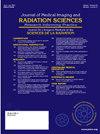Using Remotely Collected Patient-Reported Outcomes to Triage Attendance at On-Treatment Review Visits: Early Findings
IF 2
Q3 RADIOLOGY, NUCLEAR MEDICINE & MEDICAL IMAGING
Journal of Medical Imaging and Radiation Sciences
Pub Date : 2025-05-01
DOI:10.1016/j.jmir.2025.101930
引用次数: 0
Abstract
Purpose/Aim
To determine the impact of Radiation Therapists using remotely collected patient-reported outcomes (PROs) to triage attendance at on-treatment review visits.
Methods/Process
Patients who were able to communicate about medical issues in English, and were about to receive radical external beam radiation therapy (RT) for breast or prostate cancer, were approached for informed consent. Participants were randomly assigned to one of two groups: the standard of care (SOC) group attended every weekly on-treatment visit. For the intervention group (INT), their attendance was triaged by Radiation Therapists, based on PRO responses. PROs were entered by the the participants in an unsupervised manner via a smartphone application (App) less than18 hours before each scheduled review. The triggers to attend the on-treatment visit were: a PRO entry of ‘moderate’ grade or above in any domain; a specific request to attend the review visit by the participant; or last week of RT course. If these criteria were not met, the participant would skip the on-treatment review visit. Less than 24 hours after the review visit, all participants completed an evaluation of that week's on-treatment review using the App.
Results or Benefits/Challenges
To date, 36 patients have agreed to participate (30% of planned accrual). 56% were diagnosed with breast cancer, and 58% were randomized into the INT arm. The PRO completion rate was very high in both arms (97%). In the SOC arm, participants attended 96% of review visits. INT participants skipped 28% of review visits, none of these required alternative supportive services. More INT participants reported the review visits lasted more than 10 minutes compared to the SOC arm (39% vs. 18%; p 0.04). INT participants, who were triaged to attend the review visit were significantly more likely to report that all of their side effects were discussed, compared to the SOC arm (81% vs 56%; p 0.04). 100% of INT participants felt the questions in the PRO surveys helped them talk about their side effects with their RT team. There were no differences in Patient Satisfaction with Cancer Care scores between the cohorts (p 0.59). Both cohorts were very satisfied with the review visits (69%), but those in the INT arm were more likely to report that the visits were a valuable use of their time (66% vs. 55%). 92% of study arm participants felt that Radiation Therapists always or frequently made a correct triage decision.
Conclusions/Impact
The early findings from this study suggests that PRO-based triage by Radiation Therapists allowed almost 30% of patients to skip unnecessary on-treatment review visits. This improved the perceived value of on-treatment review visits, while reducing the burden on patients and healthcare systems, without compromising satisfaction with cancer care.
使用远程收集的患者报告结果在治疗复查访视中进行分诊:早期发现
目的/目的利用远程收集的患者报告结果(PROs)确定放射治疗师在治疗复查访视中分诊出勤的影响。方法/过程能够用英语交流医疗问题并准备接受根治性外束放射治疗(RT)治疗乳腺癌或前列腺癌的患者进行知情同意接触。参与者被随机分配到两组中的一组:标准护理(SOC)组每周参加一次治疗访问。对于干预组(INT),他们的出勤由放射治疗师根据PRO反应进行分类。在每次计划审查前不到18小时,参与者以无监督的方式通过智能手机应用程序(App)输入专业意见。参加治疗前访视的触发因素为:任一领域的PRO评分为“中等”或以上;参与者参加评审访问的具体要求;或者上个星期的RT课程。如果不符合这些标准,参与者将跳过治疗中复查访问。回顾访问后不到24小时,所有参与者使用app完成了对当周治疗中回顾的评估。结果或益处/挑战到目前为止,36名患者同意参加(占计划收益的30%)。56%被诊断为乳腺癌,58%被随机分配到INT组。两组的PRO完成率都很高(97%)。在SOC组中,参与者参加了96%的评审访问。INT参与者跳过了28%的复诊,这些复诊都不需要其他支持性服务。与SOC组相比,更多的INT组参与者报告审查访问持续时间超过10分钟(39% vs 18%;p 0.04)。与SOC组相比,被分类参加审查访问的INT组参与者更有可能报告讨论了他们所有的副作用(81% vs 56%;p 0.04)。100%的INT参与者认为PRO调查中的问题有助于他们与RT团队谈论他们的副作用。两组患者对癌症护理的满意度评分无差异(p 0.59)。两组患者都对复查访视非常满意(69%),但INT组患者更有可能认为复查访视是对时间的宝贵利用(66%对55%)。92%的研究组参与者认为放射治疗师总是或经常做出正确的分诊决定。结论/影响本研究的早期发现表明,放射治疗师基于pro的分诊允许近30%的患者跳过不必要的治疗复查。这提高了治疗中复查的感知价值,同时减轻了患者和医疗保健系统的负担,同时不影响对癌症治疗的满意度。
本文章由计算机程序翻译,如有差异,请以英文原文为准。
求助全文
约1分钟内获得全文
求助全文
来源期刊

Journal of Medical Imaging and Radiation Sciences
RADIOLOGY, NUCLEAR MEDICINE & MEDICAL IMAGING-
CiteScore
2.30
自引率
11.10%
发文量
231
审稿时长
53 days
期刊介绍:
Journal of Medical Imaging and Radiation Sciences is the official peer-reviewed journal of the Canadian Association of Medical Radiation Technologists. This journal is published four times a year and is circulated to approximately 11,000 medical radiation technologists, libraries and radiology departments throughout Canada, the United States and overseas. The Journal publishes articles on recent research, new technology and techniques, professional practices, technologists viewpoints as well as relevant book reviews.
 求助内容:
求助内容: 应助结果提醒方式:
应助结果提醒方式:


